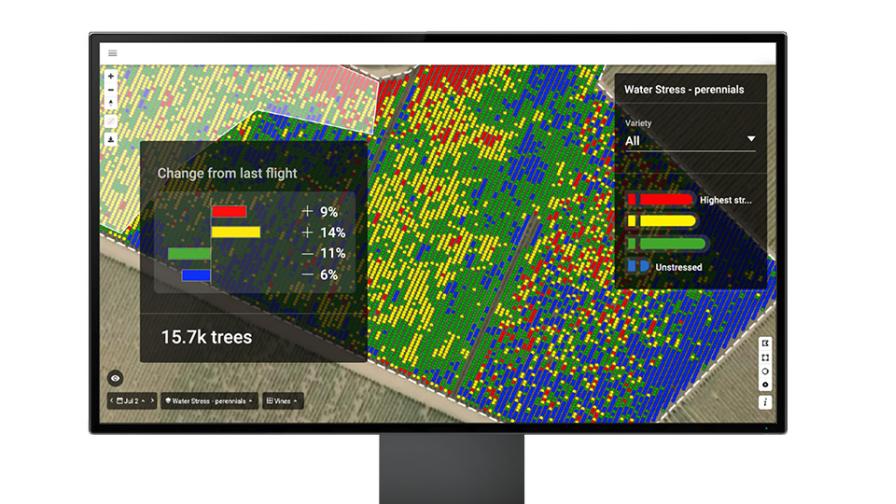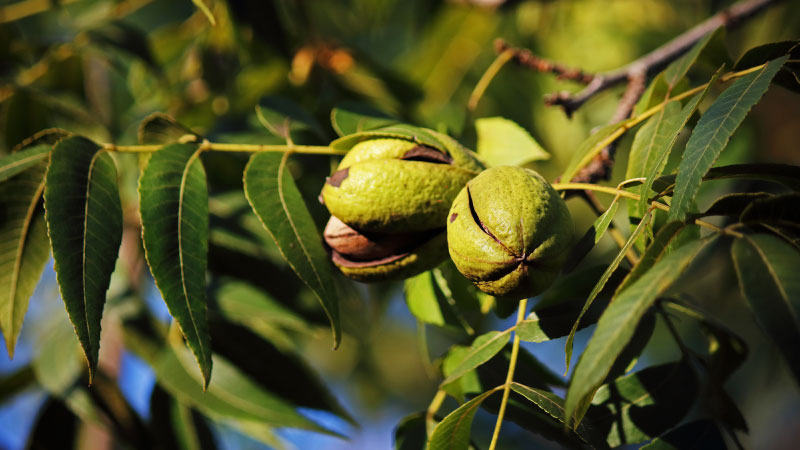Why Fruit Growers Need To Take Another Look at Their Irrigation Plan

Some companies, such as shown in this illustration from Ceres Imaging, now provide crop health data at the individual tree level to help growers optimize irrigation — even on legacy systems. Aerial analysis can be used to pinpoint common problems, such as leaks and clogs, as well as improve irrigation system uniformity.
Image courtesy of Ceres Imaging
Trevor Hardy knows a few things about irrigating an orchard. When the topic is addressed, the reigning American Fruit GrowerSM Apple Grower of the Year Award winner typically stresses the importance of planning ahead.
“You don’t always take the time to set up the equipment properly, but that is the key,” Hardy says. “I’m not going to plant those trees unless I have all those supplies in place.”
Irrigation manufacturers, not surprisingly, appreciate the stance.
“Trevor Hardy makes a great point,” Niki Tubacki, the Product Manager with Ceres Imaging, says. “Not everyone is in a position to do so, but we’ve also seen that establishing irrigation infrastructure strategically from the outset can give growers an edge in managing water in the long run.”
“I definitely agree with Trevor,” Oz Ben-David, Phytech’s Vice President of Revenue and Business Development, adds. “Failing to prepare means preparing for failure, as the saying goes. Creating and maintaining a right infrastructure for your orchard is key to a successful and efficient farming operation.”
New Game Plan
Growers who in the past planted before installing the irrigation infrastructure have learned the hard way that the infrastructure needs to come first, according to Pat Biddy, a Senior Agronomist with Irrigation Matters. One issue, Biddy says, is the high cost of labor to hand water newly planted trees without a system. A second, he says, is the ability to optimize the locations of valves and wells. Finally, the cost of replacing stock is unappealing.
“Having a system for both watering and monitoring in place from day one helps manage the health of the young stock, optimizing growth and accelerating the crop to maturity,” Biddy says.
Regulation is a factor as well, according to Matt Sani, a citrus grower in California and agronomist colleague of Biddy’s at Irrigation Matters.
“The importance of agricultural water is growing exponentially considering regulations and availability,” Sani says. “The delivery systems, efficiency, and documentation of use seems to be lagging slightly behind. Closing this gap can really provide a grower an advantage in producing the highest quality products while achieving maximum water use efficiency.
“And to Trevor’s point, planning ahead and setting up your equipment is key, and that goes for irrigation as well. Consider your irrigation system a piece of equipment. In fact, it’s probably the most used equipment on your field. Updating, maintaining, and understanding an irrigation system will always pay dividends.”
Dino (DJ) Simoni Jr., a Pest Control Adviser and Agronomist with Wilbur-Ellis, sums it up best when it comes to field prep for a permanent orchard.
“Growers have one shot in 25 to 50 years to get it done right, depending on the crop,” he says. “Otherwise, a do-over will be cost-prohibitive.”
Established Orchards
As Tubacki notes, not all growers are in the position to start from scratch.
“For most operations there are still many ways to improve and optimize irrigation strategy, even on a legacy system,” the Ceres Imaging Product Manager says. “We help our customers evaluate irrigation performance at the beginning of the season so that repairs can be identified, prioritized, and addressed before they seriously impact crop health. We also provide ongoing monitoring for the issues that spring up over the course of the season — valves malfunctioning, blocked lines, and so on —which, while minor, can have a huge impact on a crop that’s already being minimally irrigated.”
According to Ben-David, proper preparation does not only revolve around the pumps, valves, and mainlines. Included as well are frost mitigation tools, fertigation tanks, professional workforce, and pest management. “This is the ‘hardware’ part of the irrigation infrastructure,” he says.
Beyond that, in order to optimize such an investment and create an efficient operation, growers need software — “the brains,” Ben-David says — to help them manage and optimize all aspects: irrigation, nutrition, pest and disease.
“This is where Phytech is making a difference by being a holistic command center that help growers monitor, control, and automate those three key areas of their activity,” Ben-David says.
Prospera Technologies, a Valmont Company, also specializes in irrigation management software. According to Tanner Oliphant, Director of Technical Sales-North America, having an irrigation management plan in place prior to the growing season is critical to being proactive and reactive to respond to the crops’ water needs.
“Irrigation management software allows growers to connect to their pumps, valves, soil moisture probes, weather stations, etc., giving the grower full visibility and control of their entire irrigation operation from their smartphone or tablet,” Oliphant says. “These tools collect historical and current data that will help you make informed and accurate decisions. Even more, there are solutions, such as those that Valley Irrigation offers, that provide recommendations and schedules for irrigating.”
As with all technology, there is a learning curve, Oliphant says, so having the proper training on the software prior to the season can set growers up for success.
“In a time where all growers are asked to do more with less, arming yourself with data to make informed decisions or other technology that allows you to manage your operations remotely has become a necessity vs. a luxury,” he says.
Additional Recommendations
Jim Clare, the President of Pacific Southwest Irrigation, says well-designed irrigation systems typically include consideration of the terrain and the farmer’s capabilities.
“The minimum amount of water to grow a value crop — any crop — in California is 10 gallons per minute (GPM) per acre. That is, if you farm 20 acres, you must have 200 GPM available at all times,” Clare says. “Consider that the number of sets should be kept to a minimum. One set is ideal, especially with drip. More than two sets is a risk in permanent crops. Sizing pipe is crucial. Small pipe eats up power and therefore irrigation efficiencies. Make it easy to do a good job.”
Bill Terry, the Director of Business Development with WaterPoint Irrigation Technologies, endorses starting with a clean system and “keeping it that way.”
“As an example, we’re installing electronic water treatment systems instead of sulfur burners on a 1,000-acre operation of apples, pears, and cherries,” Terry says. “These electronic water treatment systems treat the water to maintain clean drip and sprinkler lines, controlling the buildup of bio, algae, and scale.”
Simoni, of Wilbur-Ellis, touts soil testing.
“I’m guessing few people do soil samples to plan the layout of their irrigation systems, but that step is critical,” Simoni says. “We suggest developing a nice grid sample that makes sense for your field and providing it to whomever is designing your system.
“You may have a sandy area in a field, or an area with a perched water table that needs to be irrigated differently. Identifying this information up front can help you better plan things, like emitter size, emitter application rate, and where to put valves to break up the field. If you can use soil texture and variability to plan your irrigation system — and to apply irrigation water more evenly and accurately – you’ll be better off in the long run.”










